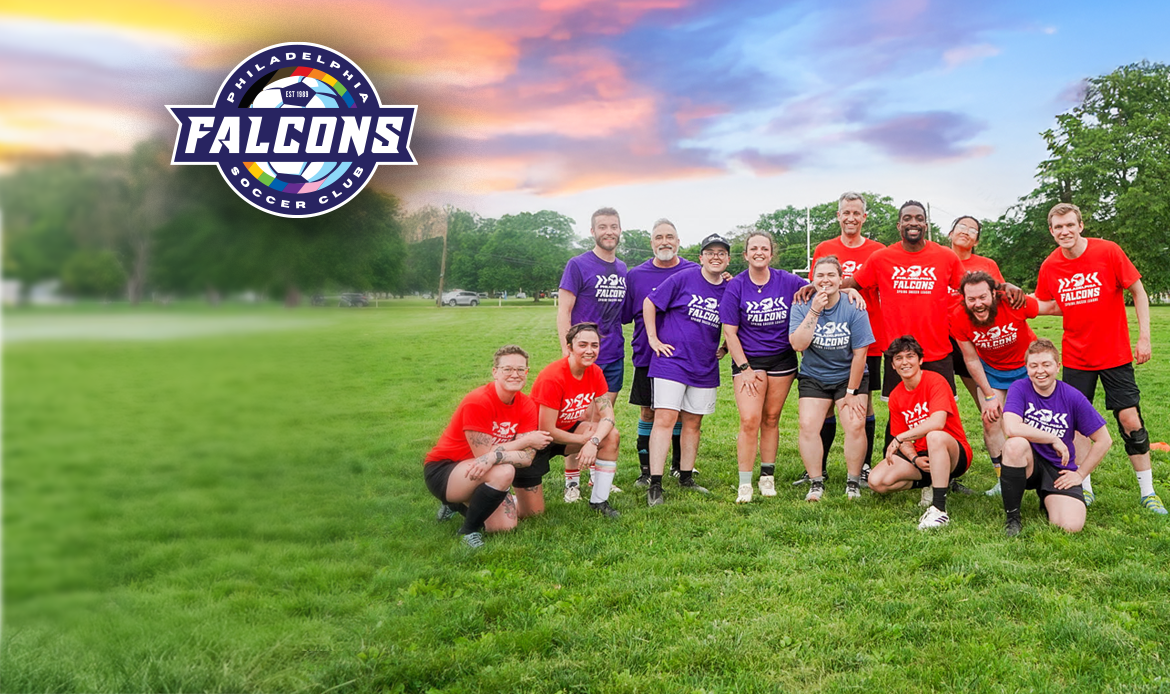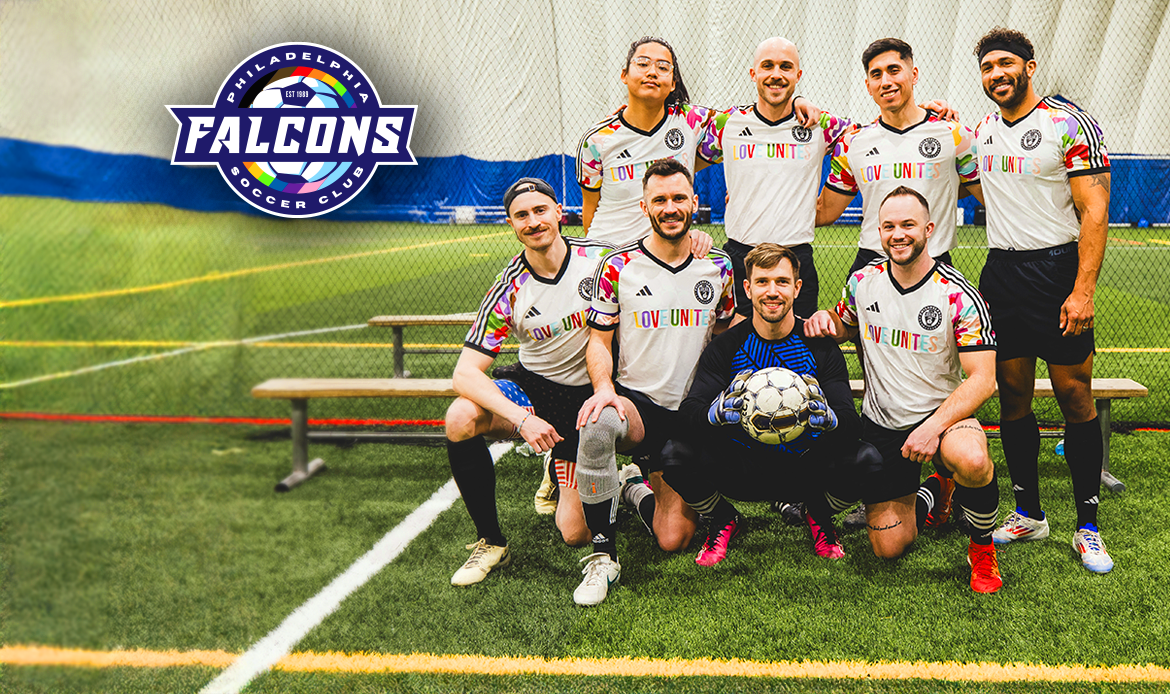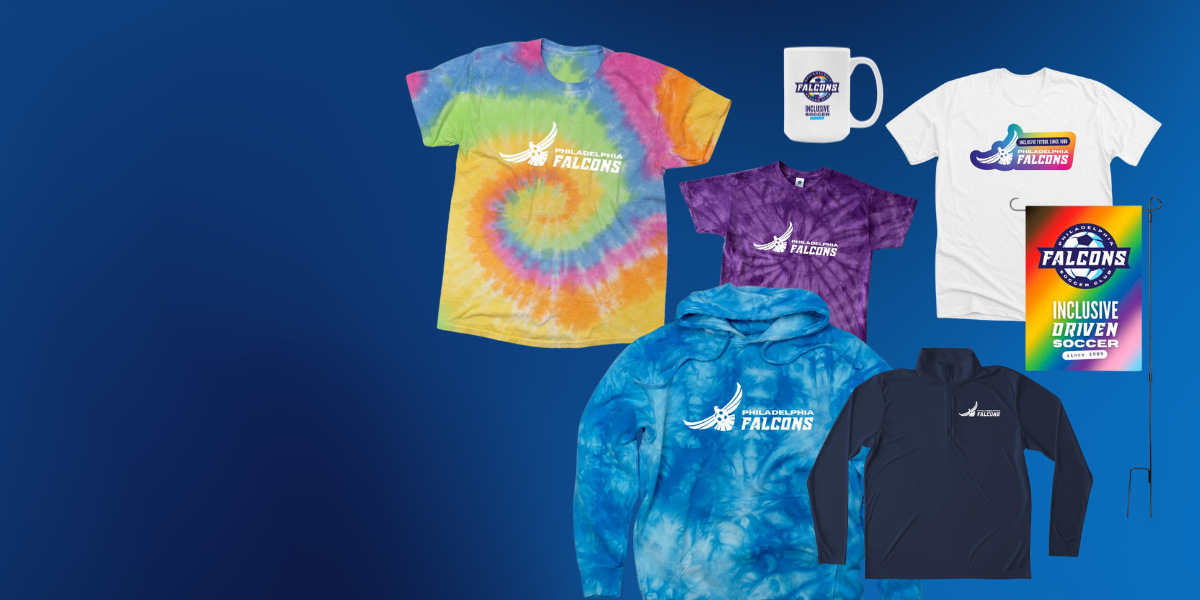Fundamental Elements of Gender & Sexuality
At the Philadelphia Falcons Soccer Club, it is our responsibility to create an environment that is affirming, enriching and as a trauma informed as possible for all the participants of all identities and backgrounds. This section will guide you through the foundational concepts that you can use.
Building a Shared Language
Since there isn't a standardized curriculum on gender or sexuality in the U.S., it's important for us to start by building a shared understanding of these core concepts and the terminology we use to describe them. Philly Falcons welcome all trans and gender-expansive folks in the world, so it's crucial that each and every person contributing to the creation and execution of this safe space is comfortable and confident using gender-affirming best practices. So let's get started! Our basic understanding of LGBTQ+ identity is shaped by four main elements: assigned sex, gender identity, gender expression, and sexual orientation. As you move through this section, think of these elements expansively, and remind yourself that you may need to unlearn some of the binary ways we’ve been taught to think about them. Some of these terms may be new to you, so pause if you need to take a moment to write down words you'd like to look up later.
Unlearning the Binary
We typically learn about gender and sexuality in a very binary way in this country. Most of us are taught - implicitly or explicitly - that if someone is born with genitals resembling a penis, they are male, they are a man, they look and act masculine and are attracted to women. Similarly, we are typically taught that if someone is born with genitals resembling a vulva, they are female, they are a woman, they look and act feminine and are attracted to men. These two pathways (outlined in the accompanying graphic) are considered society’s standard and are normalized as our “default.” As you scroll through the four elements that follow, you'll learn that this isn't actually true. In fact, our experiences of gender and sexuality are much more fluid and complex than these rigid binary categories that we've all been taught! Unlearning this can take time, especially if some of these concepts are new to you. Go at your own pace and use the graphics and videos in each section to help illustrate each one. The first component we will be unpacking is assigned sex. Why do we use the term assigned sex? This is because sex is usually determined (either during gestation or at the time of birth) by a healthcare provider simply looking at the baby's external genitalia, and assigning the baby to a sex category, usually either “male” or “female." However, this often is not an accurate representation of the sex of a human being. Scientists, biologists, and geneticists have found that these two sex categories cannot possibly fit every person. Sexual development varies widely based on several factors including internal and external reproductive organs, hormones, and chromosomes. Individuals with characteristics outside of society's rigid classifications of the sex binary are described as intersex. The term "intersex" functions as both a sex category and identity, with a variety of different genotypic (genetic) and phenotypic (observable) traits. Check out this video to hear four intersex folks share their experiences and perspectives.
Gender Identity
Now let’s talk about gender! Gender identity is a distinct concept, separate from the sex we are assigned. Gender describes our internal sense of self, who we know ourselves to be. We are typically taught that there are only two genders - “man” and “woman” - but in reality, there is a wide range of genders that exist on a broad continuum. Different people will use different language to describe their gender, and the language folks use will likely change over time, in different contexts or environments, in different languages or dialects, and as culture evolves.
For some people, their gender aligns with the sex they were assigned at birth. This is called “cisgender.” But for many others, their experience of gender is different than what they were assigned at birth. This is called “transgender.” The transgender community is not limited to just trans men and trans women; it is inclusive of nonbinary genders as well, such as agender, genderqueer, genderfluid, bigender, Two-spirit, and many more.
Note: the words 'transgender' and 'cisgender' are adjectives that describe a noun ("transgender woman") and should not be used with an -ed ("transgendered woman"). This would be the linguistic equivalent of saying "whited woman" rather than just "white woman."
Gender Expression
Gender expression describes how we communicate our gender outwardly. Expression is unique to every person, and it is the only area of gender and sexual identity that can be externally perceived - in other words, seen and experienced without using words. Some common elements of gender expression are: clothes, hairstyle and hair color, jewelry, piercings, tattoos, mannerisms, hobbies, makeup, and much more!
Gender expression is not just about communicating our gender to others; it also serves as a function for self-worth, self-love, and self-actualization. Just like gender identity, gender expression expression is not binary (just "masculine" or "feminine"). Gender expression is a fluid concept that can shift and change for each individual person, regardless of their gender identity. Different cultures have different interpretations of masculinity and femininity as well.
Since many aspects of gender expression are a conscious choice, people may choose to express their gender differently based on how comfortable and safe they feel. For example, someone may choose to express their gender one way at work, another with family, and another on a date. And finally, remember that you can't know a person's gender identity simply by observing their gender expression.
Sexual and Romantic Orientation
Sexual orientation, sometimes referred to as someone's sexuality or sexual identity, describes the ways in which we experience (or don't experience) attraction to others. Romantic orientation describes a person's pattern of romantic attraction and relationship structures. See the word cloud below for some examples of language used to describe these identities and experiences.
These pieces of our identity can be very fluid; they exist on a continuum with lots of variance in terminology and community. The language folks use to describe their sexual and/or romantic orientation may change throughout their life, and may be influenced by their cultural and environmental surroundings. Remember, while the specific language to describe orientation may be a personal choice, our innate experience of attraction is not.
What might NONbinary-based genders, sexes, and sexualities look like in the real world?
To summarize, these four elements of gender & sexuality are distinct concepts, and none of them can be used to predict or guess another. While there are elements of each that may overlap, no identity is intrinsically linked to another. So what can gender and sexuality look like in the real world? Click the bottom right of each flash card below to see hypothetical examples of the wide diversity of experiences of gender and sexuality.
While these concepts may be confusing to some of you now, the important thing to remember is that we are each the experts of our own identity and expression. If/when confusion begins to creep in, remember that respect, acknowledgement, and validating language are always a safe cushion to land on.
Keep in mind that we all have an individual experience of each of these elements: assigned sex, gender identity, gender expression, and sexual/romantic orientation. Take a moment to think about the language you might use to describe yourself in each category.
An additional concept comes into frame when we layer all of these pieces of our identity together, and begin to see a more complete picture. Our sexual and gender-related identities are only part of what makes up who we are. The layering of all of our identities (age, race, ability, nationality, class, etc.) and our resulting lived experience is called intersectionality.
Intersectionality is a concept was named and developed by Black feminist scholar Kimberlé Crenshaw in 1989. It is the interconnected nature of social categorizations as they apply to a given individual or group, regarded as creating overlapping and interdependent systems of discrimination or disadvantage. Working from a framework of intersectionality is crucial to LGBTQ+ affirmation.
We are all intersectional, with many different identities and experiences that influence the way we navigate the world. By recognizing ourselves and the people around us as whole individuals with many unique identities, we can build empathy and understanding for one another. The following video breaks down the many areas of intersectionality that affect people's everyday lives, in different ways. Take a moment to watch it and reflect on your own identities, and how they have impacted your life.
Gender-Affirming Language Matters
Correct pronoun use is a hugely important best practice, but it's not the only part of our language that can be made more inclusive and affirming. Why do the words we use matter so much?
- Whether we're talking, reading, writing, or signing, the worlds we use are toolsthat have the power to build connection and empathy.
- How we talk to (and about) LGBTQIA+ people convey how we understand, think, and feel about them.
- If you value helping over harming, using gender-affirming language is a great way to begin creating supportive, trustworthy, safe environments.
We are trying to create an environment at the Philadelphia Falcons Soccer Club (and beyond) that normalizes language that is respectful and affirming for folks of all genders and sexualities. With this in mind, let's take a closer look at other examples of language - besides pronouns - that can be adjusted or replaced with more gender-neutral and gender expansive terms.
The Difference You Can Make
As a Falcon member, you have a unique opportunity to set the tone and environment for the attendees you interact with!
Using gender-affirming language as a best practice can help to create that welcoming place for everyone at the club. How do we know? These statistics might help illustrate the difference you can make:
- Affirming transgender and nonbinary youth by respecting their pronouns and allowing them to change legal documents is associated with lower rates of attempting suicide. (Source: Trevor Project's National Survey on LGBTQ Youth Mental Health 2024)
- The vast majority of trans and gender-expansive folks who were able to transition in the workplace reported feeling more comfortable at work and believe their workplace performance improved. (Source: Out & Equal Workplace Advocates Workplace Equality Fact Sheet 2019)
- Providing gender-affirmation in social, familial, and medical settings each had independent associations with both lower depression and higher self-esteem for the trans folks in this study on transgender women.
Using Pronouns
Pronouns are the words we use to refer to ourselves or others without using a name. Some pronouns like I, you, and we, don't communicate much about gender. Others like they/them/their, she/her/hers, he/him/his, and zie/zir/zirs do. Using the correct pronouns for someone is just as important as using their correct name. Some folks use one set of pronouns, some use a combination of many pronouns interchangeably, and some use no pronouns at all.
Misgendering
Misgendering refers to someone in an inaccurately gender way, or implying that they’re a gender they’re not. Includes pronouns honorifics. Misgendering is a way of invalidating a trans person's identity. It makes them feel disrespected, isolated, uncomfortable, and hated simply because of their gender. It tells them that they should hide who they really are, that people will never fully accept them. It contributes to a culture in which hating and disrespecting trans people is the norm. Misgendering trans people is an act of violence.
Apologize
Keep it simple, but apologize quickly and sincerely. Avoid over-apologizing; center the person you harmed, not your own feelings of discomfort.
Thank the Person
Thanking the person who corrected you may be appropriate, too! They're giving you information about how to treat them (or someone else) with respect, which is certainly something to be grateful for.
Correct Yourself & Move On
Do this in the moment! All together, it might sound like: "Thanks for letting me know, I'll use Mr. from now on." or, "Sorry about that, I'll be sure to use they and she for Gina in the future."
Don't ignore misgendering when it happens around you
If you hear a person misgendering someone, correct the person kindly and quickly. For example, "Hey, Jamie actually uses she/her pronouns." or, "Sergio uses they, not he." Support the trans and gender expansive folks in your life, whether or not they're present when misgendering happens.
LGBTQIA+ Resources
William Way Community Center
The Attic Youth Center
Galaei
Mazzoni Center
Bebashi
Colours Organization
Philly Black Pride
Humans Rights Campaing
Philadelphia Family Pride
Gloria Casarez Residence
HOPEPHL
LGBTQ NATIONAL HOTLINE
TREVOR PROJECT
The Rainbow Room
Trans and Non comforming Resources
GUIDE TO BEING AN ALLY TO TRANS AND NON-BINARY YOUTH
NON-BINARY INCLUSION IN SPORTS
TRANS LIFELINE
Morris Home
Ark of Safety
National Queer and Trans Therapist of Color Network
TRANSGENDER LEGAL DEFENSE & EDUCATION FUND
Soccer & Sports Resources
IGLFA
SAFE-HUB
US SOCCER FOUNDATION
Kicking Out Transphobia
Tri-County Womens Soccer League
Philadelphia PALS
Lez Run
Mental Health Resources
NAMI PHILADELPHIA
NAMI BUCKS COUNTY
Fact Sheets in PDF Form for Mental Health Conditions
ADHD (Attention Deficit Hyperactivity Disorder)
Anxiety Disorders
Bipolar Disorder
BPD (Borderline Personality Disorder)
Depression
Dissociative Disorders
Eating Disorders
OCD (Obsessive-compulsive Disorder)
PTSD (Posttraumatic Stress Disorder)
Schizoaffective Disorder
Schizophrenia
Fact Sheets in PDF Form for Related Conditions
Anosognosia
Dual Diagnosis
Major Depressive Disorder with a Seasonal Pattern
Psychosis
Risk of Suicide
Self-harm
Sleep Disorders
Fact Sheets in PDF Form for Treatment & Services
Crisis Services
Complementary Health Approaches
ECT and Other Brain Stimulation Therapies
Medications Overview
Movement Disorders Checklist
Mental Health Professionals
Psychosocial Treatments
Psychotherapy
Treatment Settings
EN ESPAÑOL
La Salud Mental Nos Afecta a Todos
La Salud Mental
La Competencia Cultural
Como Ayudar a Un Ser Querido
Como Puedes Ayudarte
Plan en Caso de Crisis
Mitos y Verdades Sobre el Suicidio
y Preguntas que le Puedes Hacer a tu ser Querido
Trastornos de Ansiedad
Trastorno Bipolar
Trastorno Límite de la Personalidad
Diagnostico Dual
Depresión
Trastorno Por Estrés Postraumático
Trastorno Obsesivo Compulsivo
Psicosis
Esquizofrenia
El Riesgo De Suicidio
Substance Use and Recovery/ Legal
Mazzoni Center All Recovery Meeting
Morris Home
Prevention Point/Project SAFE
SOL Collective
LGBT Safe Rehab Programs
855-396-3011
We are available day and night even if you just need someone to talk to. Our admissions coordinators provide a confidential assessment and will review with you the best treatment options for the situation if you need it.
SMART Recovery
(Self-Management And Recovery Training) is not a 12-step group. It is an online 4-Point Program® that sponsors face-to-face meetings around the world, and daily online meetings to help people recover from all types of addictive behaviors. Online message board and 24/7 chat room are excellent forums to learn about SMART Recovery and obtain addiction recovery support.
LGBT-friendly 12-step meetings
(directory on pages 31-33)
ACLU of Pennsylvania works to secure total rights for LGBT people by working to defend and expand the individual rights and personal freedoms afforded to us all by the state and federal constitutions and the Bill of Rights.
Equality Pennsylvania is an organization which advocates throughout Pennsylvania for LGBT rights. Equality Pennsylvania also attempts to advance LGBT friendly policy and legislative initiatives.
Human Rights Campaign (HRC) is a civil rights non-profit organization focusing on LGBTQ issues.
Organizations
WOMEN AGAINST ABUSE SAFE HAVENS
THE LAUREL HOUSE
ACT UP PHILADELPHIA
AIDS FUND PHILADELPHIA
WOAR: Philadelphia Center Against Sexual Violence



